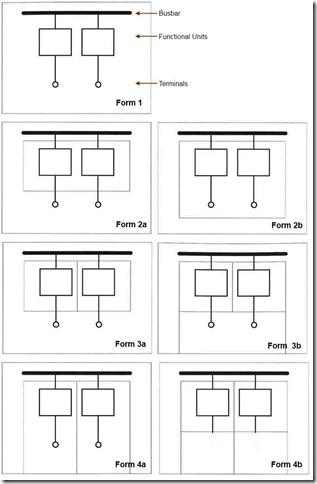Views: 3417 Author: Site Editor Publish Time: 2022-10-31 Origin: Site
IEC 61439 'Low-voltage switchgear and controlgear assemblies', specifies standard arrangements of switchboard (call forms of internal separation).
The are labelled as Form 1, Form 2, Form 3 and Form 4. Forms 2, 3 and 4 are further broken down into Form 2a, 2b, 3a, 3b, 4a and 4b.
Each Form relates to the internal separation of the busbars, functional units and terminals, each being defined as:
Main busbar - busbar to which one or more distribution busbar, incoming unit or outgoing unit can be connected
Distribution busbar - busbar in one section which is connected to the main busbar from which incoming or outgoing units can be connected
Functional Unit - part of the assembly comprising the electrical and mechanical elements that contribute to the fulfilment of the same function
Incoming unit - functional unit which feeds energy into the assembly
Outgoing unit - functional unit supplying energy to the outgoing circuits
Terminals - part of the assembly which provide for connection of incoming and outgoing cable and busbar
Internal separation is achieved by the use of barriers or partitions (including metallic or non-metallic), insulation of live parts or an integral housing (i.e. moulded case circuit breaker). The internal barriers should provide protection against contact to IP XXB and against the ingress of foreign bodies to at least IP 2X.
Form 1 has no internal separation between , while Form 4b has the greatest with busbars, functional units and terminals all being separated (see illustration):

The United Kingdom implementation of the IEC standard (in BS EN 61439-2) further defines the separation of busbars and cables by the use of Types. These have been widely adopted within and outside the United Kingdom.
| Form | Type | Construction |
|---|---|---|
| 1 | ||
| 2a | ||
| 2b | 1 | busbars separation is by an insulated covering (i.e. sleeving, wrapping, coatings, etc.) |
| 2 | busbars separated by rigid metallic or non-metallic barriers or partitions | |
| 3a | ||
| 3b | 1 | busbars separation is by an insulated covering (i.e. sleeving, wrapping, coatings, etc.) |
| 2 | busbars separated by rigid metallic or non-metallic barriers or partitions | |
| 4a | 1 | busbars separation is by an insulated covering (i.e. sleeving, wrapping, coatings, etc.) |
| 2 | busbars separated by rigid metallic or non-metallic barriers or partitions | |
| 3 | busbars separated by rigid metallic or non-metallic barriers or partitions | |
| 4b | 4 | busbars separation is by an insulated covering (i.e. sleeving, wrapping, coatings, etc.) |
| 5 | busbars separated by rigid metallic or non-metallic barriers or partitions | |
| 6 | all separation requirements by rigid metallic or non-metallic barriers or partitions | |
| 7 | all separation requirements by rigid metallic or non-metallic barriers or partitions |